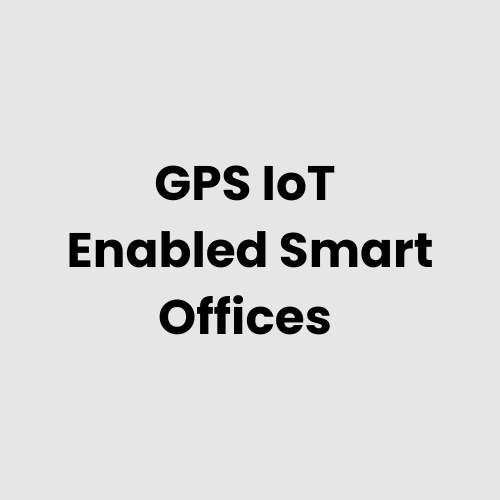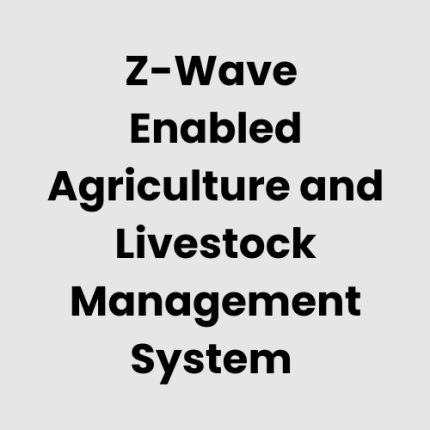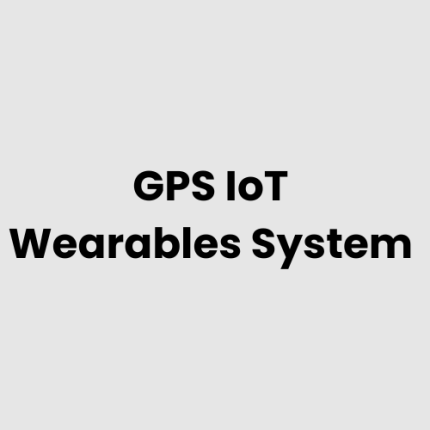GPS IoT Enabled Smart Offices
Discover the technical architecture, hardware, deployment considerations, and cloud integration for GPS IoT Enabled Smart Offices by GAO Tek, a leader in IoT solutions.
Description
GPS IoT Enabled Smart Offices – Technical Architecture
The GPS IoT Enabled Smart Offices system integrates IoT devices, sensors, and communication networks to enhance workplace productivity, efficiency, and security. The technical architecture typically consists of several layers:
- Device Layer: This includes IoT sensors, smart devices, and wearables that collect and transmit data such as occupancy, temperature, lighting, humidity, and air quality.
- Connectivity Layer: This includes the communication protocols like Wi-Fi, Bluetooth, Zigbee, and LoRaWAN, enabling data exchange between IoT devices and the cloud or local servers.
- Edge Layer: Edge computing devices may be deployed to pre-process data before it is sent to the cloud, ensuring real-time response and minimizing bandwidth usage.
- Data Processing Layer: This layer involves cloud or local servers where data is stored, analysed, and processed. Advanced analytics software may be used to generate insights for energy management, space utilization, and more.
- User Interface Layer: The data is accessible via dashboards and mobile apps, enabling building managers and employees to monitor and control various smart office features, such as adjusting lighting, temperature, or booking rooms.
Hardware of GPS IoT Enabled Smart Offices
- IoT Sensors: Occupancy sensors, temperature and humidity sensors, air quality sensors, lighting control sensors.
- Smart Devices: Smart lighting systems, smart thermostats, smart locks, automated blinds.
- Gateways and Hubs: These devices collect and transmit data from the sensors to local servers or cloud infrastructure.
- Edge Devices: Small, powerful devices for processing and analysing data closer to the source before sending it to the cloud.
- Servers: Local or cloud servers for processing, storing, and analysing data collected from the devices.
- User Interfaces: Tablets, touch panels, or apps for office managers and employees to interact with the system.
Physical Placement Considerations of the Hardware
- Sensors: Position sensors like occupancy and temperature sensors at strategic locations such as entrances, conference rooms, and individual workstations. Ensure sensors are placed at optimal heights to provide accurate readings.
- Gateways: Gateways should be centrally located to ensure maximum coverage of the IoT devices, typically in the server room or near a central point of connectivity.
- Edge Devices: These devices should be placed close to key data-generating devices to ensure minimal latency in data processing.
- Smart Devices: Smart lighting and thermostats should be installed where control over lighting and HVAC is most needed, such as in offices, conference rooms, and hallways.
Hardware Architecture of GPS IoT Enabled Smart Offices
The hardware architecture of a GPS IoT-enabled smart office system consists of several interconnected components:
- IoT Sensors and Devices: These devices collect real-time data on environmental conditions and occupancy.
- Edge Computing Devices: Edge devices receive and process data locally, enabling near-instant responses for real-time applications.
- Gateways and Network: Gateways act as intermediaries, transmitting data between sensors and local/cloud servers using wireless communication technologies.
- Centralized Servers or Cloud: Data collected from all devices are transmitted to a central server or cloud for further processing, storage, and analysis.
- User Interface: Dashboards and applications that display real-time data, insights, and allow users to manage devices and settings.
Deployment Considerations of GPS IoT Enabled Smart Offices
When deploying a GPS IoT Enabled Smart Office system, several factors need to be considered:
- Scalability: The system should be scalable to accommodate the growing needs of office spaces, as the number of IoT devices may increase over time.
- Integration: Ensure the IoT system integrates seamlessly with existing office infrastructure, such as HVAC, lighting, security systems, and IT networks.
- Security: Deploy robust security measures to protect sensitive data, including encryption, secure access control, and regular software updates.
- Energy Efficiency: The deployment should focus on optimizing energy usage, leveraging IoT data to enhance the building’s energy management systems.
- User Training: Office staff and building managers should be trained on how to use and maintain the system for maximum efficiency.
List of Relevant Industry Standards and Regulations
- ISO/IEC 30141:2018 – Internet of Things (IoT) Reference Architecture
- ISO/IEC 27001:2013 – Information Security Management
- IEC 62443 – Industrial Communication Networks Security
- GDPR – General Data Protection Regulation
- IEEE 802.15.4 – Low-Rate Wireless Personal Area Networks
- UL 2900 – Cybersecurity Assurance for IoT Devices
- ANSI/BICSI 002-2014 – Data Centre Design and Implementation
- NIST SP 800-53 – Security and Privacy Controls for Information Systems
- EN 300 328 – Standards for WLAN Devices in the European Union
- ITU-T Y.2060 – IoT Framework Standard
Local Server Version
For enterprises looking to maintain control over data and infrastructure, a local server version of the GPS IoT Enabled Smart Office system can be deployed. This version processes and stores data locally, within the company’s on-premises server environment. It’s ideal for businesses that require strict control over their data or need to comply with regional data privacy laws.
Key features:
- Local Data Processing: Data is processed locally, reducing latency and ensuring real-time response to office conditions.
- Data Privacy: Organizations maintain full control over their data storage and processing.
- Customizable Infrastructure: The local server can be tailored to specific business requirements, such as custom security protocols or integration with legacy systems.
Cloud Integration and Data Management
Cloud integration plays a crucial role in the GPS IoT Enabled Smart Offices system. By using cloud platforms, businesses can take advantage of the scalability, accessibility, and powerful computing capabilities of the cloud to store and analyse vast amounts of data.
Data Management Features:
- Centralized Data Storage: Data from all office IoT devices is transmitted to the cloud for centralized storage, making it accessible from any location.
- Real-Time Analytics: The cloud provides tools for analysing data in real-time, offering insights on office usage, energy efficiency, and environmental conditions.
- Data Security: Cloud providers offer robust security measures, including encryption and secure data access protocols, ensuring sensitive office data is protected.
- Scalability: The cloud infrastructure can easily scale to handle more devices as the office system grows over time, ensuring seamless performance.
- Remote Access: Cloud-based systems allow authorized users to access and control the office system remotely, enhancing flexibility in managing the environment.
At GAO Tek Inc., we specialize in providing comprehensive GPS IoT-enabled smart office solutions designed to streamline operations, optimize energy usage, and improve office environments. With a proven track record in IoT and smart technologies, we offer tailored solutions that align with the specific needs of modern office spaces. Our system integrates seamlessly with existing infrastructure and can be deployed locally or in the cloud, ensuring flexibility and security for all types of office environments. Our dedicated team provides expert support, ensuring successful implementation and optimal performance throughout the lifecycle of your smart office system.
GAO Case Studies of GPS IoT Enabled Smart Offices
USA Case Studies
- New York City, New York
A large financial institution in New York City implemented a GPS IoT-enabled smart office system to optimize energy use and improve employee productivity. The system helped monitor office space occupancy, regulate lighting and HVAC systems, and ensure a comfortable and energy-efficient environment. Real-time data analysis provided valuable insights, enabling more efficient office management.
- San Francisco, California
A technology company in San Francisco deployed a smart office system to automate meeting room bookings, manage lighting based on occupancy, and monitor air quality. The GPS IoT system increased operational efficiency, providing real-time feedback for space utilization, ultimately improving the company’s sustainability efforts and employee well-being.
- Chicago, Illinois
A commercial office building in Chicago integrated GPS IoT-enabled systems to reduce energy consumption. By automating lighting and HVAC controls, the system reduced operational costs and provided tenants with real-time energy consumption data. The building’s management team benefited from predictive analytics that helped them make data-driven decisions for maintenance and upgrades.
- Austin, Texas
A tech start up in Austin adopted a GPS IoT-enabled smart office system to enhance employee comfort and optimize workspace management. The system tracked meeting room availability, regulated temperature and lighting based on occupancy, and improved air quality, fostering a productive and pleasant working environment.
- Los Angeles, California
A corporate headquarters in Los Angeles implemented a GPS IoT-based solution for comprehensive building management. The system integrated security, energy usage, and room occupancy data into one platform. This streamlined facility management, lowered costs, and ensured a safer and more comfortable workspace for all employees.
- Seattle, Washington
A global tech firm in Seattle utilized a GPS IoT-enabled system to enhance space efficiency and promote sustainability. The system collected data on building occupancy and environmental conditions, adjusting lighting and HVAC systems based on usage patterns, contributing to improved energy savings and a healthier office atmosphere.
- Boston, Massachusetts
A commercial office building in Boston adopted a smart office solution to create an efficient, flexible workspace. The GPS IoT-enabled system helped track space utilization, allowing the management team to make better-informed decisions about office layout and resource allocation while enhancing employee comfort and productivity.
- Denver, Colorado
A co-working space in Denver integrated GPS IoT-enabled technologies to manage occupancy and optimize energy use. The system enabled automatic adjustment of lighting, temperature, and meeting room availability. Data collected helped optimize floor plans, reducing energy waste and improving operational efficiency.
- Washington, D.C.
A government agency in Washington, D.C., implemented GPS IoT-enabled smart office technologies to improve environmental control and employee comfort. The system monitored occupancy, air quality, and energy consumption, ensuring compliance with sustainability goals while providing a comfortable work environment for employees.
- Miami, Florida
A high-rise office building in Miami used a GPS IoT-based smart office system to improve operational efficiency and reduce energy costs. The system provided real-time data on energy consumption and office space usage, enabling building management to adjust settings for better resource utilization and reduced environmental impact.
- Philadelphia, Pennsylvania
A corporate office in Philadelphia utilized a GPS IoT-enabled system for efficient resource management and improved security. The system tracked space usage, controlled building lighting, and automated HVAC systems, reducing operational expenses and ensuring a safer, more productive environment for employees.
- Phoenix, Arizona
A healthcare provider in Phoenix deployed GPS IoT-enabled systems to streamline building management and ensure a comfortable workplace. The system integrated occupancy sensors, energy management controls, and environmental sensors to maintain optimal conditions for both staff and patients, enhancing workplace efficiency and comfort.
- Portland, Oregon
A corporate office in Portland implemented a GPS IoT system to streamline energy management. The system collected data on office occupancy and usage patterns, automating lighting and HVAC controls. This resulted in significant energy savings while enhancing the comfort of employees in the building.
- Minneapolis, Minnesota
A law firm in Minneapolis used a GPS IoT-enabled system to improve operational efficiency and resource management. By automating lighting, HVAC systems, and space bookings, the system enhanced productivity and helped reduce costs. The building’s energy consumption was closely monitored and adjusted to optimize efficiency.
- Salt Lake City, Utah
A financial services company in Salt Lake City leveraged a GPS IoT-enabled smart office system to manage workspace usage and improve energy efficiency. The system monitored occupancy patterns, adjusted environmental conditions, and provided data to optimize space utilization, helping to reduce energy costs and improve employee satisfaction.
Canada Case Studies
- Toronto, Ontario
A corporate office in Toronto integrated a GPS IoT-enabled smart office system to improve the office environment and reduce operational costs. The system automated HVAC and lighting, tracked space utilization, and monitored air quality. This approach resulted in enhanced comfort for employees and more efficient use of energy resources.
- Vancouver, British Columbia
A tech start up in Vancouver deployed GPS IoT-enabled smart office systems to improve workspace management and reduce energy consumption. The system automatically adjusted temperature, lighting, and ventilation based on occupancy, helping to optimize energy usage and improve employee comfort. The real-time data provided valuable insights for further space optimization.
Navigation Menu for GPS IoT
- GPS IoT Trackers/Devices
- GPS IoT Tracking Accessories
- GPS IoT Tracking Resources
- GPS IoT – Cloud, Server, PC & Mobile Systems
Navigation Menu for IoT
- LORAWAN
- Wi-Fi HaLow
- Z-WAVE
- BLE & RFID
- NB-IOT
- CELLULAR IOT
- GPS IOT
- IOT SENSORS
- EDGE COMPUTING
- IOT SYSTEMS
Our products are in stock and can be shipped anywhere in the continental U.S. or Canada from our local warehouse. For any further information, please fill out this form or email us.
We are actively looking for partners who are like us located in the U.S. and Canada. For more information on partnering with GAO, please visit Partner with GAO Tek Inc. It lists various ways to partner with GAO, such as OEM Partnerships, Technology Integration, Distribution and Reselling Opportunities, Presenting at the Leading Event Tek Summit, Joint R&D Projects, Training and Consulting Services, Industry-Specific Collaborations, Research and Academic Partnerships.



